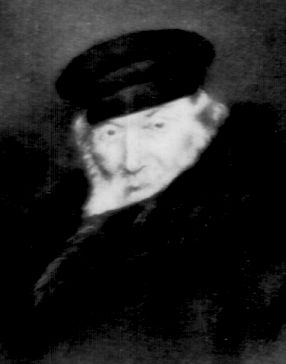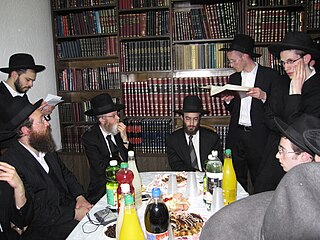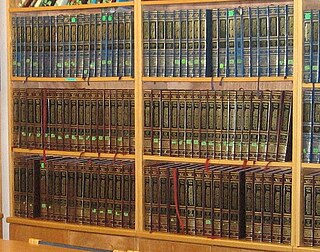
Rabbinic literature, in its broadest sense, is the entire corpus of works authored by rabbis throughout Jewish history. The term typically refers to literature from the Talmudic era, as opposed to medieval and modern rabbinic writings. It aligns with the Hebrew term Sifrut Chazal, which translates to “literature [of our] sages” and generally pertains only to the sages (Chazal) from the Talmudic period. This more specific sense of "Rabbinic literature"—referring to the Talmud, Midrashim, and related writings, but hardly ever to later texts—is how the term is generally intended when used in contemporary academic writing. The terms mefareshim and parshanim almost always refer to later, post-Talmudic writers of rabbinic glosses on Biblical and Talmudic texts.

The Gemara is an essential component of the Talmud, comprising a collection of rabbinical analyses and commentaries on the Mishnah and presented in 63 books. The term is derived from the Aramaic word גמרא and rooted in the Semitic word ג-מ-ר (gamar), which means "to finish" or "complete". Initially, the Gemara was transmitted orally and not permitted to be written down. However, after Judah the Prince compiled the Mishnah around 200 CE, rabbis from Babylonia and the Land of Israel extensively studied the work. Their discussions were eventually documented in a series of books, which would come to be known as the Gemara. The Gemara, when combined with the Mishnah, forms the full Talmud.

A yeshiva is a traditional Jewish educational institution focused on the study of Rabbinic literature, primarily the Talmud and halacha, while Torah and Jewish philosophy are studied in parallel. The studying is usually done through daily shiurim as well as in study pairs called chavrusas. Chavrusa-style learning is one of the unique features of the yeshiva.

Torah study is the study of the Torah, Hebrew Bible, Talmud, responsa, rabbinic literature, and similar works, all of which are Judaism's religious texts. According to Rabbinic Judaism, the study is done for the purpose of the mitzvah ("commandment") of Torah study itself.

The Mishnah Berurah is a work of halakha by Rabbi Yisrael Meir Kagan. It is a commentary on Orach Chayim, the first section of the Shulchan Aruch which deals with laws of prayer, synagogue, Shabbat and holidays, summarizing the opinions of the Acharonim on that work.

Yisrael Meir ha-Kohen Kagan was an influential Lithuanian Jewish rabbi, Halakhist, posek, and ethicist whose works continue to be widely influential in Orthodox Jewish life. He was known popularly as the Chofetz Chaim, after his book on lashon hara, who was also well known for the Mishna Berurah, his book on ritual law.

The SeferChofetz Chaim is a book by Rabbi Yisrael Meir Kagan, who is also called "the Chofetz Chaim" after it. The book deals with the Jewish laws of speech.
Daf Yomi is a daily regimen of learning the Oral Torah and its commentaries, in which each of the 2,711 pages of the Babylonian Talmud is covered in sequence. A daf, or blatt in Yiddish, consists of both sides of the page. Under this regimen, the entire Talmud is completed, one day at a time, in a cycle of approximately seven and a half years. As of today, January 2, 2025, the study is of Tractate Sanhedrin, page 16.

Yeshivas Chofetz Chaim is an Orthodox yeshiva based in Kew Gardens Hills, Queens, New York, United States. It is primarily an American, non-chasidic Haredi Talmudic yeshiva. The yeshiva is legally titled Rabbinical Seminary of America (RSA) but is often referred to as just Chofetz Chaim as that was the nickname of its namesake, Yisroel Meir Kagan. It has affiliate branches in Israel and North America.

Siyum HaShas is a celebration of the completion of the Daf Yomi program, a roughly seven-and-a-half-year cycle of learning the Oral Torah and its commentaries, in which each of the 2,711 pages of the Babylonian Talmud are covered in sequence – one page per day. The first Daf Yomi cycle began on the first day of Rosh Hashanah 5684 ; the thirteenth cycle concluded on 4 January 2020 and the fourteenth cycle began the following day, to be concluded on 7 June 2027. The Siyum HaShas marks both the end of the previous cycle and the beginning of the next, and is characterized by celebratory speeches, as well as singing and dancing. The next day, the new cycle begins again.

Shemaryahu Yosef Chaim Kanievsky was an Israeli Haredi rabbi and posek. He was a leading authority in Haredi Jewish society on legal and ethical practice. Known as the Gadol HaDor and the "Prince of Torah", much of his prominence came through Torah education and advice about Jewish law.

A siyum ("completion"), in Judaism, occasionally spelled siyyum, is the completion of any established unit of Torah study. The most common units are a single volume of the Talmud, or of Mishnah, but there are other units of learning that may lead to a siyum.

Chachmei Lublin Yeshiva was a Jewish educational institution (yeshiva) that operated in the city of Lublin, Poland from 1930 to 1939. At the time, it was one of the largest in the world.

Chona Menachem Mendel (Mendel) Weinbach was an Orthodox Jewish rabbi, educator, author, and speaker. As the co-founder and dean of Ohr Somayach Institutions, a Jerusalem-based yeshiva for newly-observant Jewish men, he was considered one of the fathers of the modern-day baal teshuva movement.
Amud Yomi "column [of the] day" or "daily page") is a daily regimen undertaken to study the Babylonian Talmud one amud each day..
Kollel Bet Mordechai is a kollel and bet midrash in Johannesburg, South Africa. It is associated with Mizrachi and is based at the Yeshiva College of South Africa.

The Schottenstein Edition of the Babylonian Talmud is a 20th-century, 73-volume edition of the Babylonian Talmud featuring an elucidated translation and commentary, and published by ArtScroll, a division of Mesorah Publications.

Hadran is a short prayer recited upon the completion of study of a tractate of the Talmud or a Seder of Mishnah. It is also the name of the scholarly discourse delivered at a siyum masechet, the ceremony celebrating the completion of study of a Talmudic tractate.

Rabbanit Malke Bina is the founder and first teacher of Matan Women's Institute for Torah Studies. She has a master's degree in Hebrew Bible from Yeshiva University. She is married to a rabbi and is called by the term Rabbanit, which is less common in Modern Orthodox circles. Malke Bina does not consider herself a Rabbi and, at a 2004 conference of Orthodox Jewish Feminists, emphasized her focus on Talmud study. She was interviewed by JOFA in 2006 and serves on its Council of Advisers. She also pioneered women's reading of Megillat Esther on Purim.
In Judaism, Mishnah Yomis or Mishnah Yomit refers to the Torah study cycle in which two Mishnahs are learned every day. It takes about 6 years to study all six tractates of the Mishnah using this learning cycle. Previous cycles of the Mishnah Yomis began on 22 Tamuz 5770, and 20 Adar-B 5776. The current cycle began on Shabbat, 21 Tevet 5782.

















